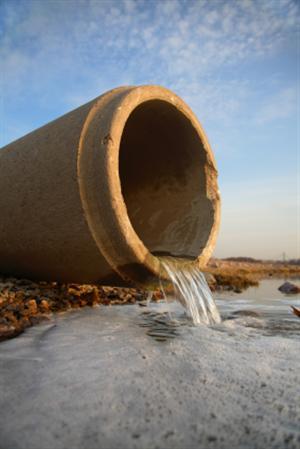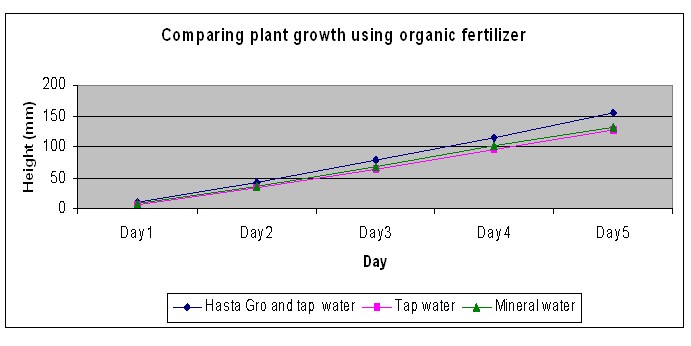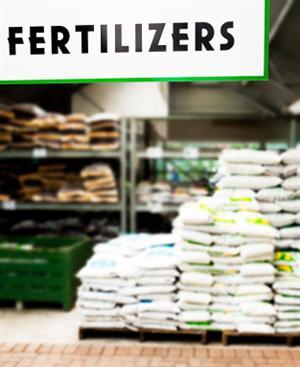| Complexity level: | 2 |
| Project cost ($): | 20 |
| Time required: | 1 day to prepare, 5 days for observation |
| Material availability: | Easily found |
| Safety concerns: | NA |
Hypothesis
Watering haseolus aureus (mung beans) with organic fertilizer (as opposed to inorganic fertilizers) will help them grow faster.
Overview
Organic plant food
Organic fertilizers (like Hasta Gro) are safer to use compared to chemical fertilizers. Some chemical fertilizers can be dangerous to humans and animals. When it rains, the chemical fertilizers are washed off our lawns and drain into local water catchments (eg. our reservoirs, lakes and ponds). The fish and other aquatic life, as well as animals living in or around the ponds may be poisoned and die due to the toxic content in the chemical fertilizer.
The organic fertilizers may contain water, urea, extracts from seaweeds, some micronutrients, humic acid and some extracts from the process of fermentation. The compounds found in organic fertilizers help to increase the amount of microbes in the soil. This will help to change the composition of the nutrients in the soil so that they are more easily absorbed by plants.
Scientific Terms
Materials
The materials required for this experiment:
- Mung beans
- 9 pots
- Soil required for the 9 pots
- Hasta Gro fertilizer (or any other brand of organic fertilizer)
- Tap water
- Mineral water
- Ruler (1 meter)
- 3 watering cans
Procedure
- For this experiment, the independent variable is the composition of the water used to water the plants (ie: organic fertilizer, tap water and mineral water). The dependent variable is the rate of growth of the bean plants. This is determined by measuring the average height of the 3 plants in each group. The constants (control variables) are the amount of water used and the type of plant used, as well as the amount of sunlight and temperature conditions.
- The 9 pots are filled with the same amount of soil. A mung bean is placed in each pot.
- Prepare 1 liter of each kind of watering solution and fill the 3 watering cans accordingly. Label them clearly:
- Tap water with Hasta Gro
- Tap water
- Mineral water
- The pots are divided into 3 groups with 3 pots in each group. They are labeled as group A, group B and group C.
- Group A plants are watered with tap water mixed with Hasta Gro fertilizer as indicated in the instructions.
- Group B plants are watered with tap water.
- Group C plants are watered with mineral water
- The bean plants are watered as mentioned above and observed for 5 days. Their height is measured everyday and recorded in the table below.

Results
It is observed that the plant in group A will grow tall the fastest. The plant in group B and group C grow slower but at almost the same pace.
Use this table below to help record the bean plants daily height (in mm).
| Group | Plant | Plant Height measured in mm | ||||
| Day 1 | Day 2 | Day 3 | Day 4 | Day 5 | ||
| A Hasta Gro and tap water | Plant 1 | 10 | 44 | 82 | 116 | 162 |
| Plant 2 | 12 | 41 | 78 | 116 | 155 | |
| Plant 3 | 11 | 41 | 74 | 110 | 148 | |
| Average | 11 | 42 | 78 | 114 | 155 | |
| B Tap water | Plant 1 | 6 | 32 | 61 | 92 | 121 |
| Plant 2 | 7 | 32 | 65 | 97 | 130 | |
| Plant 3 | 8 | 35 | 67 | 99 | 133 | |
| Average | 7 | 33 | 64 | 96 | 128 | |
| C Mineral water | Plant 1 | 9 | 38 | 71 | 106 | 137 |
| Plant 2 | 7 | 35 | 64 | 96 | 125 | |
| Plant 3 | 8 | 35 | 69 | 104 | 134 | |
| Average | 8 | 36 | 68 | 102 | 132 |
Use the graph below to plot the results of the table above.
Conclusion
The hypothesis that watering a mung bean plant with organic fertilizer will help it grow faster is proven to be true. The organic fertilizer contains nutrients required by the plant and the soil. By increasing the concentration of nutrients in the soil, the roots of the plant are able to absorb these nutrients more quickly and this speeds up growth, which will result in faster production of stems and leaves.
Chemical pesticides and fertilizers can be more effective then organic fertilizers. However these chemical pesticides and fertilizers are toxic and dangerous to both poeple and animals. When it rains these harmful chemicals drain into rivers or seep into the water table underground. Some of this water ends up in our reservoirs- the source of our drinking water!
Another problem with chemical fertilizers is that the presence of these toxic chemicals in ponds and rivers has been known to cause birth deformities in animals which are dependent on these water resources. With an increasing awareness of the harmful effects of chemical fertilizers, the use of organic fertilizers should be encouraged among consumers.
Also consider
What would happen if the experiment was repeated using different types of soil like sand, clay etc?
The experiment can be repeated to compare the use of organic fertilizers and chemical fertilizers.
References
A great alternative to chemical fertilizers ?Hasta Gro organic food plant - http://www.epinions.com/review/Hasta_Gro_POrganic_Plant_Food_Gallon/content_44027628436
Plant growth and development - http://www.caf.wvu.edu/~forage/growth.htm

